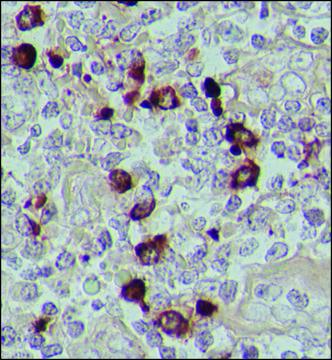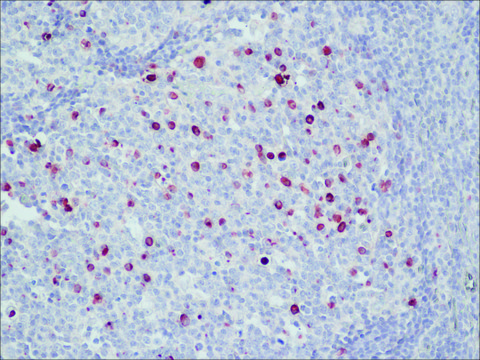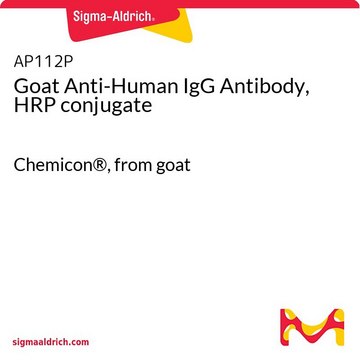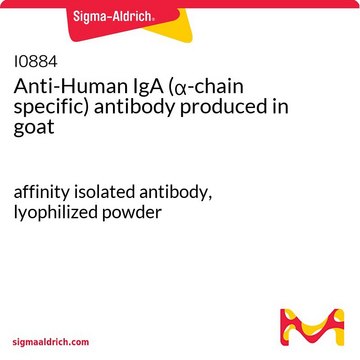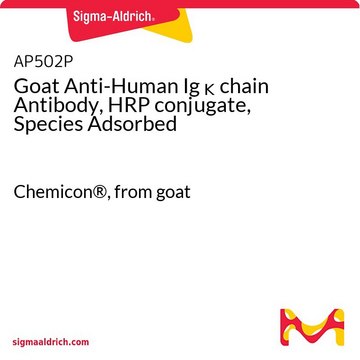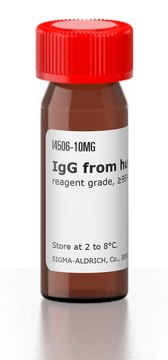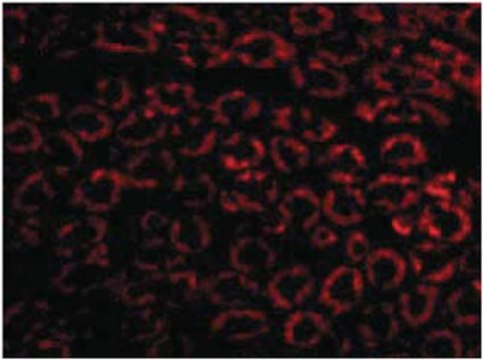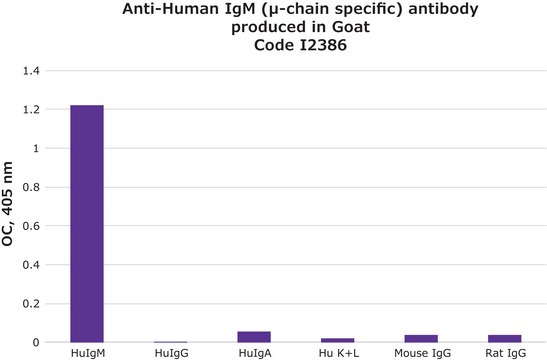AP120P
Goat Anti-Human IgA Antibody, IgG, and IgM, HRP conjugate
Chemicon®, from goat
Sign Into View Organizational & Contract Pricing
All Photos(1)
About This Item
UNSPSC Code:
12352203
eCl@ss:
32160702
NACRES:
NA.46
Recommended Products
biological source
goat
Quality Level
conjugate
peroxidase conjugate
antibody form
affinity purified immunoglobulin
antibody product type
secondary antibodies
clone
polyclonal
species reactivity
human
manufacturer/tradename
Chemicon®
technique(s)
ELISA: suitable
immunohistochemistry: suitable
western blot: suitable
shipped in
wet ice
target post-translational modification
unmodified
Related Categories
General description
IgG is the most abundant immunoglobulin comprising two heavy chains and two light chains. Each molecule has two antigen binding sites. IgG has 4 subclasses: IgG1 (66%), IgG2 (23%), IgG3 (7%) and IgG4 (4%). IgM constitutes about 10% of serum immunoglobulins. IgM (with IgD) is the major immunoglobulin expressed on the surface of B cells. Monomeric IgA constitutes 5-15% of the serum immunoglobulins whereas dimeric IgA is localized to mucosa surfaces.
Specificity
The antibody reacts with human IgG, IgM and IgA. May also react with the light chains of other human immunogloibulins.
Immunogen
Prepared from purified human IgG, IgM and IgA.
Application
Detect Human IgA using this Goat anti-Human IgA Antibody, IgG & IgM, HRP conjugate validated for use in ELISA, WB, IH.
EIA: 1:5,000-1:100,000.
Western blots: 1:5,000-1:200,000.
Immunohistochemistry: 1:500-1:5,000.
Optimal working dilutions must be determined by the end user.
Western blots: 1:5,000-1:200,000.
Immunohistochemistry: 1:500-1:5,000.
Optimal working dilutions must be determined by the end user.
Research Category
Secondary & Control Antibodies
Secondary & Control Antibodies
Research Sub Category
Whole Immunoglobulin Secondary Antibodies
Whole Immunoglobulin Secondary Antibodies
Physical form
ImmunoAffinity Purified
Purified by immunoaffinity chromatography using antigen coupled to agarose beads. Lyophilized. Buffer is 0.01 M Sodium Phosphate, 0.25 M NaCl, pH 7.6 with 15 mg/mL BSA. Contains no preservative.
Storage and Stability
Maintain lyophilized product at 2°-8°C for up to 12 months from date of receipt. After reconstitution the product is stable for six weeks at 2°-8°C as an undiluted liquid. Reconstitute vial with 2 mL of distilled water. For extended storage after reconstitution, add an equal volume of glycerol to make a final concentration of 50% glycerol followed by storage at -20°C in undiluted aliquots for up to 12 months. Please note the concentration of antibody (and buffer salts) will decrease to one-half of the original after the addition of glycerol and final working dilutions must be adjusted accordingly. Avoid repeated freeze thaw cycles.
Legal Information
CHEMICON is a registered trademark of Merck KGaA, Darmstadt, Germany
Disclaimer
Unless otherwise stated in our catalog or other company documentation accompanying the product(s), our products are intended for research use only and are not to be used for any other purpose, which includes but is not limited to, unauthorized commercial uses, in vitro diagnostic uses, ex vivo or in vivo therapeutic uses or any type of consumption or application to humans or animals.
Not finding the right product?
Try our Product Selector Tool.
Storage Class Code
11 - Combustible Solids
WGK
WGK 3
Certificates of Analysis (COA)
Search for Certificates of Analysis (COA) by entering the products Lot/Batch Number. Lot and Batch Numbers can be found on a product’s label following the words ‘Lot’ or ‘Batch’.
Already Own This Product?
Find documentation for the products that you have recently purchased in the Document Library.
Amit K Singh et al.
Journal of clinical virology : the official publication of the Pan American Society for Clinical Virology, 141, 104879-104879 (2021-06-22)
Highly sensitive nucleic acid amplification tests (NAATs) designed to detect SARS-CoV-2 RNA are the standard of care for the diagnosis of COVID-19. However, the accuracy of these methods for the quantitation of active virus rather than non-infectious RNA fragments that
Shin Urai et al.
Journal of neuroendocrinology, 36(6), e13395-e13395 (2024-04-18)
Anti-pituitary-specific transcription factor-1 (PIT-1) hypophysitis, a paraneoplastic syndrome resulting from an autoimmune response against PIT-1, typically manifests with undetectable levels of growth hormone (GH) and prolactin (PRL), and significantly low levels of serum thyroid-stimulating hormone (TSH) at diagnosis. These hormonal
Nancy J Andersen et al.
Journal of immunological methods, 404, 24-32 (2013-12-18)
The study was designed to determine the sensitivity and reproducibility of recovering immunoglobulin (Ig) isotypes (IgG subclasses, IgA, IgE and IgM classes) from dried blood spots (DBS), a methodologic subcomponent of the Upstate KIDS Study. A multiplexed Luminex assay was
Robert Root-Bernstein
Frontiers in pediatrics, 2, 85-85 (2014-09-06)
Molecular mimicry theory (MMT) suggests that epitope mimicry between pathogens and human proteins can activate autoimmune disease. Group A streptococci (GAS) mimics human cardiac myosin in rheumatic heart disease (RHD) and coxsackie viruses (CX) mimic actin in autoimmune myocarditis (AM).
Our team of scientists has experience in all areas of research including Life Science, Material Science, Chemical Synthesis, Chromatography, Analytical and many others.
Contact Technical Service